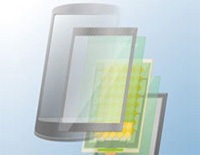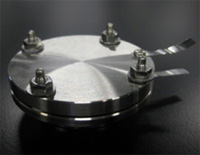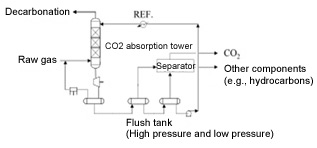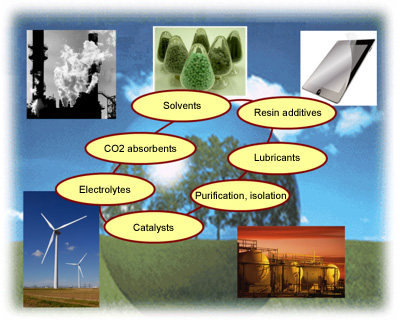
- Product information
- Product information on ionic liquids
- Purposes of use
Purposes of use of ionic liquids
1.Antistatic agents

Ionic liquids can be used as antistatic agents by adding them to resins. As they are involatile and highly heat-resistant, they can be used in processes subjected to high temperatures. They are also characterized by high transparency and insusceptible to environmental (humidity) conditions.
2.Electrolytes

The application of ionic liquids to electrochemical devices such as electric double-layer capacitors (EDLC), lithium-ion batteries (LIB) and dye-sensitized solar cells (DSSC) is also anticipated. Ionic liquids have enormous potential for solving various problems associated with existing electrolytes. This includes safety enhancements by taking advantage of their non-volatility and flameproofness, and improved battery performance by utilizing their high electric conductivity and high potential window.
3.Solvents

In recent years, development of environment-friendly "clean processes" has become an urgent topic in the chemical industry, and ionic liquids are drawing global attention in just such a field of "green chemistry." Ionic liquids do not disperse into environments as they can be easily isolated and reused by heating and separating.
Ionic liquids are also drawing attention as excellent reaction solvents in terms of safety because they have negligent vapor pressure and are non-volatile and flameproof.
Our company has developed an "ionic liquid for dissolving cellulose."
4. CO2 absorbents

Carbon dioxide (CO2) is one of the greenhouse gases said to be causing climate change. Because ionic liquids do not elute to a gaseous phase due to their low vapor pressure, they can be used across a wide temperature range and are flameproof, thus safe. gDevelopment of CO2 separation and recovery processes from combustion exhaust gases utilizing ionic liquidsh is progressing.
5.Lubricants
Lubricants are used in a variety of mechanical systems and serve to reduce friction between bodies and improve energy efficiency. As ionic liquids have negligible vapor pressures, their utilization as a lubricant in vacuum is being explored.

